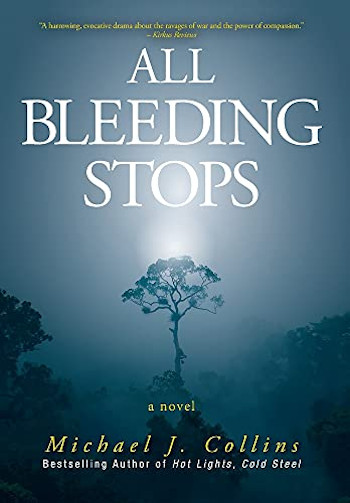A Doctor Slowly Unravels at the Height of the Vietnam War in ‘All Bleeding Stops’

CHAPTER ONE
Da Nang
Republic of Vietnam
May 1967
His war begins with a quiet palette of turquoise and green; soft, shaded layers of blue and white layered like quicklime over all the darkness to follow. The plane banks left. Their shadow, a hundred yards behind them, flits over the shimmering surface of the South China Sea. Ahead, blue waters lap against brilliant white sand. A canopy of jungle fronting the beach glows green in the slanting rays of the late-afternoon sun. Dark clouds drift north, trailing languid sheets of rain that caress the fecund forests below. In the distance, jagged mountains heave themselves upward, their peaks glistening in the sun, their eastern slopes skittering earthward into the deepening shadows of night. Bluebells in a graveyard. The rouge daub of the embalmer’s art.
Perhaps it is what the eye chooses not to see that matters. An amaurosis fugax of the soul. One more minute, one more hour salvaged from the dark, looming abattoir of war. All the while his plane thunders onward, downward, his reverie shattered for good when the plane and its shadow, having drawn closer and closer together, achieve their inevitable union. Black tires screech on bleached tarmac. A blur of vegetation out the window, engines roaring in reverse, passengers thrown forward, then back. The plane slows, taxis, and finally jerks to a halt in front of a dirty concrete bunker with a dented steel door flanked by two boarded-up windows that glower at them in the last rays of the dying sun. “Welcome to Viet fucking Nam,” the marine next to him mutters

CHAPTER TWO
The Emergency Room
Loyola University Medical Center Maywood, Illinois
May 2017
All the bleeding, all the screaming, all the pain. At some point it simply became too much, and now the ER itself is in extremis. Burned and battered patients are crammed into every examination room, every office, every hallway. More casualties arrive every minute. Unregistered, unnamed, they are wedged into corners and crannies where they lie moaning and unattended. Doctors in wrinkled green scrubs hunch over shattered bodies, stanching bleeding, inserting tubes, barking orders. Nurses, harried and blood-spattered, start IVs, dress wounds, administer meds. Lab techs, vials of blood held aloft, wriggle through the bedlam toward the pathology lab. X-ray techs, intimidated by the doctors’ furious shouts and frantic gestures, ram their machines through the jumbled mass of gurneys. Near the entrance, one of the orderlies helps a paramedic wheel in a man whose right leg is missing. An ever-weaker pulse of blood oozes through the soggy dressing that clings to his ragged stump. An intern, strings of greasy black hair dangling in front of his eyes, straddles a man with an open chest wound, trying to perform CPR, but his hands keep slipping off the man’s bloody chest. On the other side of the room, beneath the mural of Jesus curing the blind man, one of the trauma residents slaps defibrillation paddles on the chest of a man with a dark, gaping hole where his left arm used to be.
The air is hot and heavy, thick with the smell of blood, iodine, and sweat: the pungent aromas of death in a big-city ER. The plane and the neighborhood where it crashed are still in flames. Everyone’s heard a different story. It was terrorism. No, it was mechanical. There are a hundred dead. No, two hundred. At this point no one is sure of anything. Thirty ambulances have already arrived at the Loyola ER. More roar in every minute. There isn’t enough room for them in the bay, so the drivers pull their rigs as close as they can, throw open the back doors, and rush their mangled patients inside. Squad cars and ambulances—doors open, lights flashing, radios squawking—are scattered all over the parking lot.

Megan Parker jerks to a halt at the entrance to the emergency room, scarcely recognizing the place where she has worked for the last two months. Although her name tag says “MD,” Megan is only an intern. She has just come from the night shift at Jack’s Grill where she moonlights two nights a week as a waitress. Her hair smells of onions, her skin feels like grease, and she hasn’t slept in twenty-seven hours. She stands at the entrance, assaulted by more images of pain and suffering than she ever imagined possible: the jagged end of a tibia sticking through a pair of orange yoga pants; a burned arm, red, raw, and blistered, dangling from the side of a cart; a dirty eyeball floating in a basin; a broken set of dentures on the floor; an exposed breast, the nipple gone; a child, shoeless, standing alone in a corner, hands at her side, tears streaming down her face.
As a little girl, Megan dreamed of becoming a doctor, of helping people, of making a difference in their lives. She realizes her time has come. She is needed—right here, right now. She wants to do her part, but she is only ten months out of med school. Where should she go? What should she do? Tom Lynch, the surgery chief resident, sees her. He grabs her by the shoulders, spins her around, and nudges her toward a man on a cart. “Megan, take care of that guy!” She stumbles forward. Her eyes widen. She has seen a lot of things during her year as an intern but never anything like this. Curled on his left side in the fetal position lies a white-haired old man covered in dirt, dried blood, and charred shreds of clothing. His clenched hands grasp the base of a dirty, two-foot-long metal shaft that has been driven into his abdomen. The man’s eyes are closed. He is not moving.

Megan hesitates. Take care of him? Take care of him where? There’s not an inch of room left in this place. “Megan!” the chief resident shouts, “Move it!” She looks at the chaotic scene in the ER, looks back at the man on the cart, then shrugs, and squeezes around to the foot of the cart. She backs it out the door, plowing between two paramedics trying to force their way in. The cart shivers and jolts over the rough pavement as she wheels it around the corner and down the sidewalk to the delivery door next to Security. She rattles the handle, but the door is locked. “Shit!” She pounds on it three times. No one answers. She pounds again. Nothing. Across the driveway on the loading dock, the workers straighten up and gape at the man with a metal shaft sticking out of his belly. “Come here!” Megan shouts to a stocky Black man in a sleeveless T-shirt. He points at himself. “Me?” “Yes, you. Come here and stay with this man.” “What do you mean stay with him?” he shouts as she runs off. “I ain’t no doctor. What the hell am I supposed to do? Hey! Come back here!”
Megan tears back to the emergency room, pushes through the crowd at the door, then bulls her way through the mass of doctors, nurses, techs, and patients to the roped-off construction area behind the ER. She ducks under the rope, pushes aside the rolling scaffold, turns the corner, sprints down the empty hallway, and bangs open the delivery door at the far end. She finds the dockworker standing four feet away from the cart, shaking his head, staring at the man’s abdomen. “Jesus Christ,” he says. “Jesus Christ.” Megan steps in front of him, pushes the cart in the door, and wheels it down the hall, bouncing over fragments of two-by-fours and electrical conduits until she reaches the new OB/GYN room. She yanks open the door. The room, not scheduled to open for another week, is empty except for two white plastic buckets of adhesive and four rolls of drywall tape piled in the corner. The smell of fresh paint and sawdust lingers in the air. Megan pushes the cart inside. The heavy steel door snicks shut behind her, and the room suddenly becomes so quiet she can almost hear the wild, frantic pounding of her heart as it thunders the beat of all her youthful insecurities.
This is an excerpt from the new book, All Bleeding Stops (FriesenPress), by Michael J. Collins. It’s published here with permission.
Highbrow Magazine
Image Sources:
FriesenPress
Pexels (Creative Commons)
Tho-Ge (Pexels, Creative Commons)
Gcasacols (Pxhere, Creative Commons)






























































































































































































































































































































